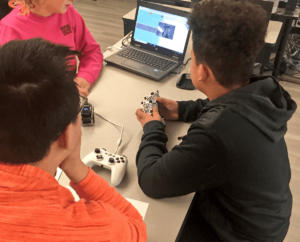Smart Laws of Technology
 John Smart is a futurist that works with some of my former colleagues from the X Prize Foundation. He’s the founder and president of the Acceleration Studies Foundation (ASF, Accelerating.org) a nonprofit community that seeks to help individuals better understand and manage continuous accelerating change. Two of his four Laws of Technology have big edtech implications.
John Smart is a futurist that works with some of my former colleagues from the X Prize Foundation. He’s the founder and president of the Acceleration Studies Foundation (ASF, Accelerating.org) a nonprofit community that seeks to help individuals better understand and manage continuous accelerating change. Two of his four Laws of Technology have big edtech implications.
The first generation of any technology is often dehumanizing. The second generation is generally ambivalent to humanity. The third generation, with luck, becomes net humanizing.
John suggests that this pattern is often observed across the history of industrialization and tech diffusion, for example:
- automobiles: first generation uses dirty fossil fuels and originally had few safety features
- televisions: first generation are noninteractive and separate and deeducate us almost as much as they socialize us
- computers: first generation are expensive and have terrible interfaces and are restricted to an educated technological elite
- the internet: first generation is buggy, primitive, hacker-infested, and far too anonymous
- cell phones: first generation increase motor vehicle accidents as they require too much human attention
Smart explains:
It is a constant challenge to the designers and users of any technology to seek ways to minimize the duration and extent of the negative externalities we so often see with any new technological deployment…Those who would criticize a technology as dehumanizing and unacceptable would do well to realize that developmental advances have always always been associated with disruption and some degree of dehumanization, as we learn to adapt to the new order of things. Fortunately, the faster and more intelligent our technology becomes, the greater the social standard we can hold it to, and the sooner we can move it from dehumanization and disruption to enhancement in its net effect.
The first generation of online learning was flat and sequential with little social interaction–not a great option for most students. Second generation components are engaging, adaptive, and social. The third generation–a few years away–these components will be part of a learning platform ecosystem with tools and school models that make the benefits widely available to most teachers and students.
Technology learns about ten million times faster than we do.
Smart explains:
It seems we all need to get used to this fact of modern life. Whether you measure it by communication (input, output) rates, computation (memory, processing) or replication rates, technological evolutionary development (and, I assume, evolutionary developmental learning, such as that which lead to human intelligence) generally runs at least seven orders of magnitude (10 million times) faster than genetic systems with regard to important rates of computational change.
In education, we talk about ‘learning technology’ but there is little talk about ‘technology learning.’
Other sectors already benefiting from Big Data use data mining strategies to help understand consumer behavior and target service offerings. The engines behind intelligent scoring systems and recommendation algorithms of smart tutoring systems are two early examples of technology that ‘learns’ with use.
For more, see Smart’s Laws of Technology:
| Laws of Development [1][2][3] |
| Laws of Technology [1][2][3][4] ]Laws of Information Theory [1][2][3][4] |
Laws of Prediction [1][2][3





0 Comments
Leave a Comment
Your email address will not be published. All fields are required.